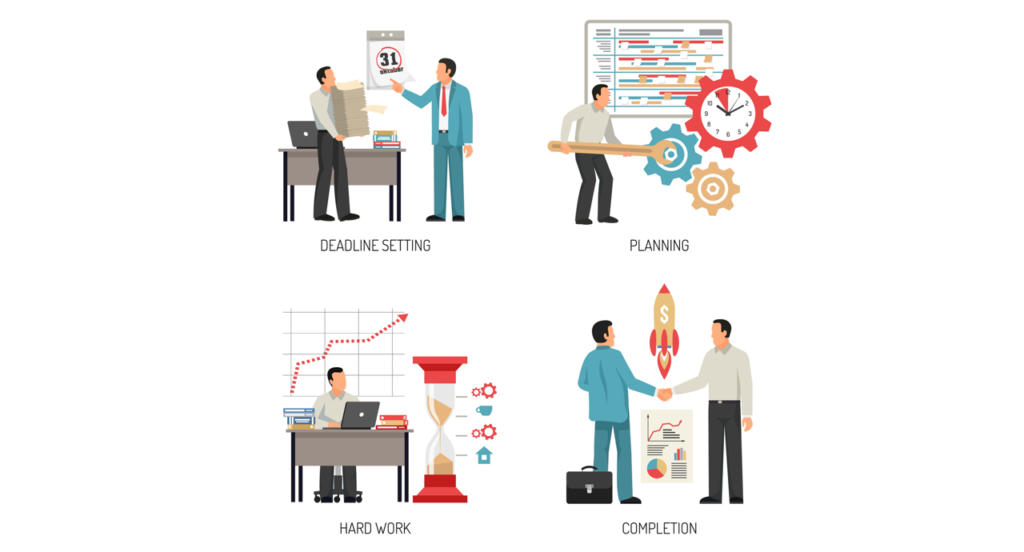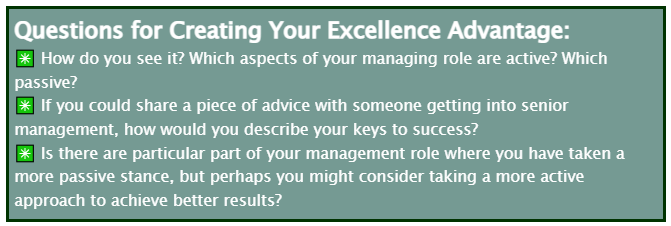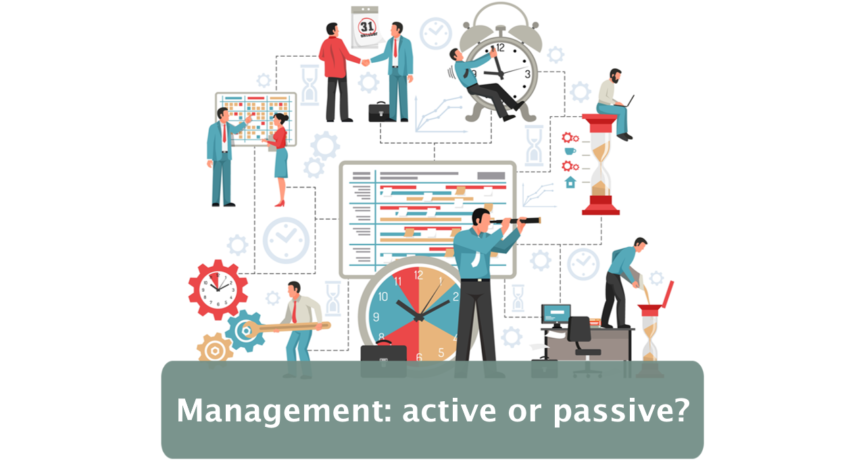Management: active or passive?
I was having a conversation recently with a senior leader about the word “management.” The conversation really got me thinking..
We were crafting a strategic objective related to ensuring the success of a particular service line on an ongoing basis. We had proposed the phrasing “Manage the performance of the X service line to ensure long-term success with…”
This senior leader client reflected, “I know this may sound odd, but to me the word manage is passive.”
Long pause as I took that in…
You see, to me the word manage or management has always been an active word; in fact, very active!
Whether in Project Management, Performance Management, Event Management, or Senior Management, the term management has always conjured up active – both pro-active and re-active – and in the case of Crisis Management, uber-active.
Project Management
Is there a period within a project where managing the project is passive? Perhaps, in a few places…
But, so many more phases where active management is the name of the game:
- Defining the project’s purpose, scope, key objectives: Active
- Gaining approval and funding for the project: Active
- Establishing the project plan including sequencing of phases, securing the people for the project, and engaging key stakeholders/ partners: Active
- Preparing the project team in order for them to skillfully carry out the project: Active
- Monitoring the project to ensure steady progress against the objectives, according to the plan, and within the approved budget: In my experience, this needs to be Active.
- — However I find organizations where this is done too passively… up until the project manager (or their boss!) discovers that the project is not going to come in “on time” or “on budget”. Then, and often too late, they re-act and move into active management.
- Identifying and removing obstacles: Active
- Project closure: Done well, this too should be active to ensure learnings are captured, documentation is secured for long-term reference, and the team is appropriately recognized.
Perhaps that period of time between when the project plan has been established, the team and stakeholders have been enlisted and up until the project runs into its first major pothole – that initial period of cruising along can feel more passive.
But I cannot think of a single project that I have managed where everything has gone exactly as planned without encountering and working through challenges on the way to success.

Crisis Management
Active.
Active.
Active.
…And to the point of exhausting for those managing a crisis that lasts for a long period of time.
Event Management
For many years my sister was in event management: managing all aspects of big events from concept to preparation, from securing the venue to managing the flow of the event (the day of).
Her tireless efforts on the day of the event were focused on spotting things that were not going as expected and finding a just-in-time solution so that in the eyes of the host & hostess it all went off seamlessly.
To her tired feet at the end of 16 hour days, to her sore arms from rearranging furniture to accommodate the extra 20 guests that showed up unexpectedly, to her watchful eyes constantly scanning the scene – all of these were signs of the very active nature of managing an event.
And so it is in senior management in my experience.
Senior Management coupled with Performance Management
Where might these seem active versus passive?
- Setting the strategic direction of the organization: Active
- Establishing annual (or 90 day) action plans: Active
- Defining the means by which you’ll ensure progress – both “progress to plan” and progress against the key metrics of success: Active. Active
- Making decisions about best sponsors, leads, and teams to carryout key growth, improvement, and strategic initiatives: Active
- Coaching & developing your direct reports, as individuals and as a team, to lead, manage, and deliver results within their areas of responsibility: Active
- Creating relationships with key collaborators and partners: Active
- Monitoring and evaluating organizational performance: Active
- Establishing an environment of high performance: Active
Perhaps, when all of these approaches delineated above are solidly in place in a consistent way, you as the executive leader of the organization/program/division can work with greater ease as everyone works together, in alignment, toward commonly agreed upon objectives, with methods to ensure progress.
But, getting all of those approaches in place is very active work, often over many years, to establish your well-integrated management system.
In my experience, once established, that humming organizational engine still requires continual and active monitoring, fine-tuning, and decision-making.
As we are managing and monitoring, we need to act on what we find. For example:
- Operating margin is well under budget. How will we rapidly create the needed shift from losses to gains before we severely impact our reserves?
- Employee retention at an all-time low. How do we need to redesign our work to take into account that we now have fewer seasoned professionals with critical thinking skills they have earned from decades of experience? How do we design our work instead with far more staff who are in the early stages of their career who need to build judgment through lived experience?
- Steady to declining numbers of new customers over the last several quarters. Why? What are their needs that might be different from our existing customers? Do we need to design a new offering or a new entry point into our existing offerings?
So, while across the years there will be periods of smooth sailing, in my experience there will be many more periods of active management when the seas get rough, the winds shift direction, members of the crew get sick, and/or when you find the course you are headed on is no longer the right destination for your mission.

If you’d like to receive these Inspirations in your inbox every other week, you can subscribe to Kathy’s Excellence Advantage Inspirations Newsletter.
Kathy Letendre, President and Founder of Letendre & Associates, advises organizations and leaders to create their excellence advantage.
Contact Kathy by phone or text at 802-779-4315 or via email.

